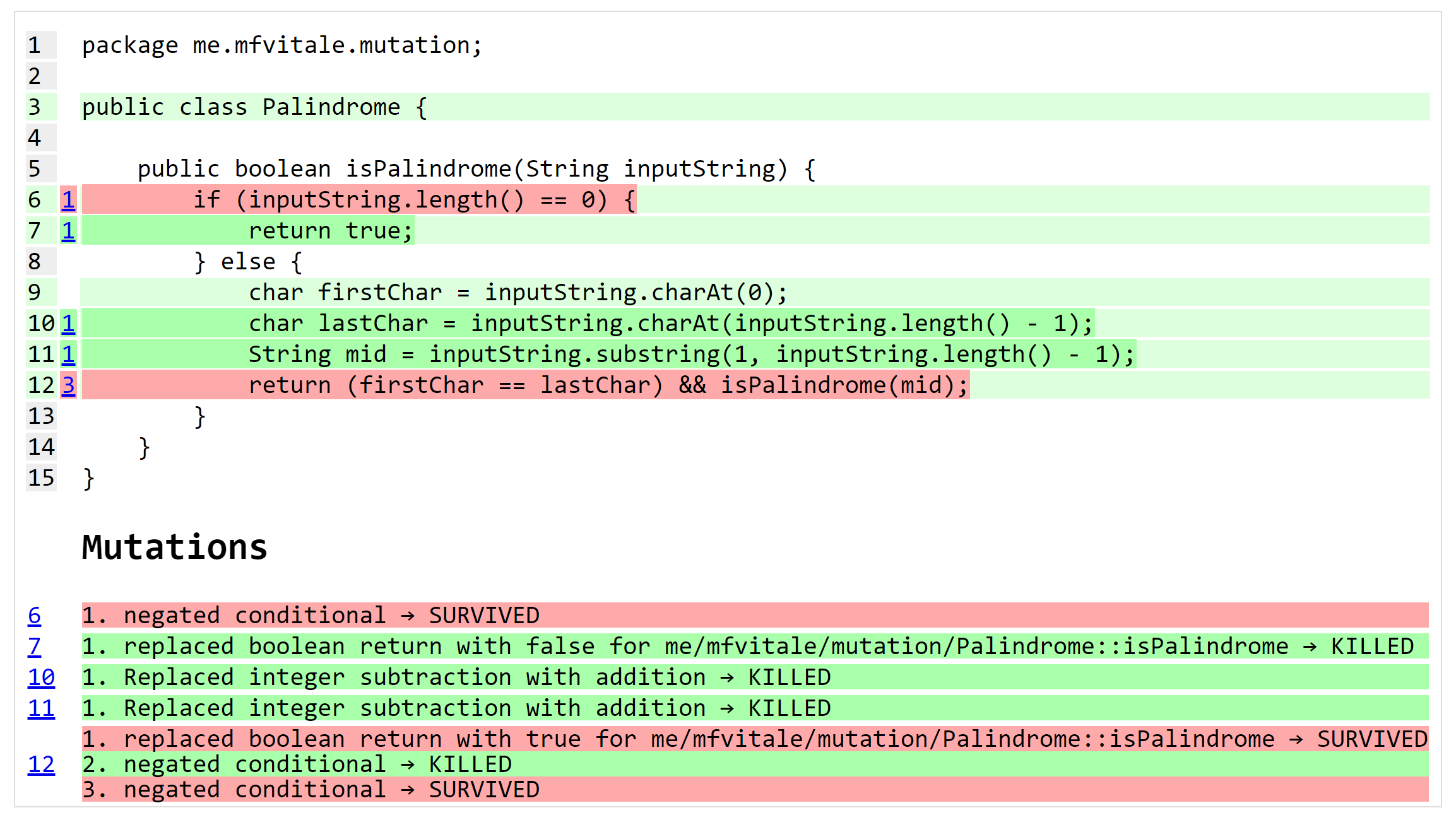How many of you heard at least one time in their career this sentence: “We must have a code coverage >= 80% for release to production”?

![]()
![]()
![]()
As for all absolute measurement, you should pay attention and treat it carefully. That’s why I agree with the following sentence
Code coverage is a side effect, not a goal. The only time I find the metric useful is when I’m working with legacy and want to have an indication if there are tests for the part of the code I’m interested in.
— Sandro Mancuso (@sandromancuso) February 2, 2019
I think that sometimes (lot of times) this “number” is used only as a goal but it should be a “tool” for developers to understand the fragility of the code that they are going to change.
- High coverage

- Low coverage

So how I can say that my code has a good quality? Certainly doing tests and so having good coverage but..this is not sufficient. Who tests the quality of your test?!
This is where mutation tests come in handy.
What is mutation testing?

Mutation tests are a new type of software testing to test the quality of your test! They work changing some code and see if some tests fail. I see in this type of tests an analogy with chaos enginering
Chaos engineering is the discipline of experimenting on a software system in production in order to build confidence in the system’s capability to withstand turbulent and unexpected conditions.
Basic concept
A mutation is a change automatically seeded into your code that can be killed if your tests fail, or lived if your tests pass! The quality of your tests can be gauged from the percentage of mutations killed.
Very simple!
Coverage vs Mutation
For example, the following code is an implementation to check if a string is a palindrome.
public class Palindrome {
public boolean isPalindrome(String inputString) {
if (inputString.length() == 0) {
return true;
} else {
char firstChar = inputString.charAt(0);
char lastChar = inputString.charAt(inputString.length() - 1);
String mid = inputString.substring(1, inputString.length() - 1);
return (firstChar == lastChar) && isPalindrome(mid);
}
}
}
and this is the tests that
public class PalindromeTest {
@Test
@DisplayName("Passing noon to isPalindrome must return true")
public void when_pal() {
Palindrome fb = new Palindrome();
assertTrue(fb.isPalindrome("noon"));
}
}
has a code coverage of 100% but mutation coverage is instead of 57%.
 in details
in details

Let’s analyze the result starting from the green lines: 7, 10, 11, and 12 so KILLED mutations:
7. in case we change the return true to return false when the length is 0, our test obviously fails so mutation is caught and killed!
10 and 11. in that case adding 1 instead to subtract it will cause an ArreyOutOfBoundException and our test will fail. Even in that case, we killed the mutation.
12.2 in that case the first condition of the return statement is negated and our test will fail. Mutation killed!
let’s now analyze the red lines: 6, 12 so SURVIVED mutations:
6. in case we negate the condition on length, returning true when length is not 0, our test will pass so the change SURVIVED. Not good!
Solution add a test with an empty string and expect isPalindrome return true.
12.1 in that case if the return statement in the else will always return true, our test will pass an so the change SURVIVED.
12.3 in that case we are denying the ‘&&’ condition of the return statement, so we are considering only the first and the last char to say if a string is a palindrome or not. Our test will pass and so the change SURVIVED
Solution for 12.* add a test to verify also when a string (with length > 2) is not a palindrome.
@Test
@DisplayName("Passing empty string to isPalindrome must return true")
public void when_empty_pal() {
Palindrome fb = new Palindrome();
assertTrue(fb.isPalindrome(""));
}
@Test
@DisplayName("Passing mario string to isPalindrome must return false")
public void when_not_pal() {
Palindrome fb = new Palindrome();
assertFalse(fb.isPalindrome("mario"));
}
@Test
@DisplayName("Passing neon string to isPalindrome must return false")
public void whenNearPalindrom_thanReject(){
Palindrome palindromeTester = new Palindrome();
assertFalse(palindromeTester.isPalindrome("neon"));
}
Note that the last test on “neon” is required to also kill mutation in the second part of the return condition. In that case, we will have 100% mutation coverage.

PIT, Java mutation tests library
There are different libraries to enable mutation testing but I think that for the Java world the best is PIT. It’ very simple to use:
First of all add
<plugin>
<groupId>org.pitest</groupId>
<artifactId>pitest-maven</artifactId>
<version>LATEST</version>
</plugin>
to your pom.xml and, if you are using Junit5, you need to add these dependency to plugin
<dependencies>
<dependency>
<groupId>org.pitest</groupId>
<artifactId>pitest-junit5-plugin</artifactId>
<version>0.12</version>
</dependency>
</dependencies>
remember to add also surfire plugin to execute test with maven
<plugin>
<groupId>org.apache.maven.plugins</groupId>
<artifactId>maven-surefire-plugin</artifactId>
<version>3.0.0-M5</version>
</plugin>
Now, you can run:
mvn test
mvn pitest:mutationCoverage
after the execution finish, you can find the report in ‘target/pit-reports’
You can find the project example here
Conclusion
What we have seen is that code coverage alone is not a good indicator of quality, we need also something to test the quality of our tests. If you put together high code coverage and mutation coverage you can have a great measure of your code quality!